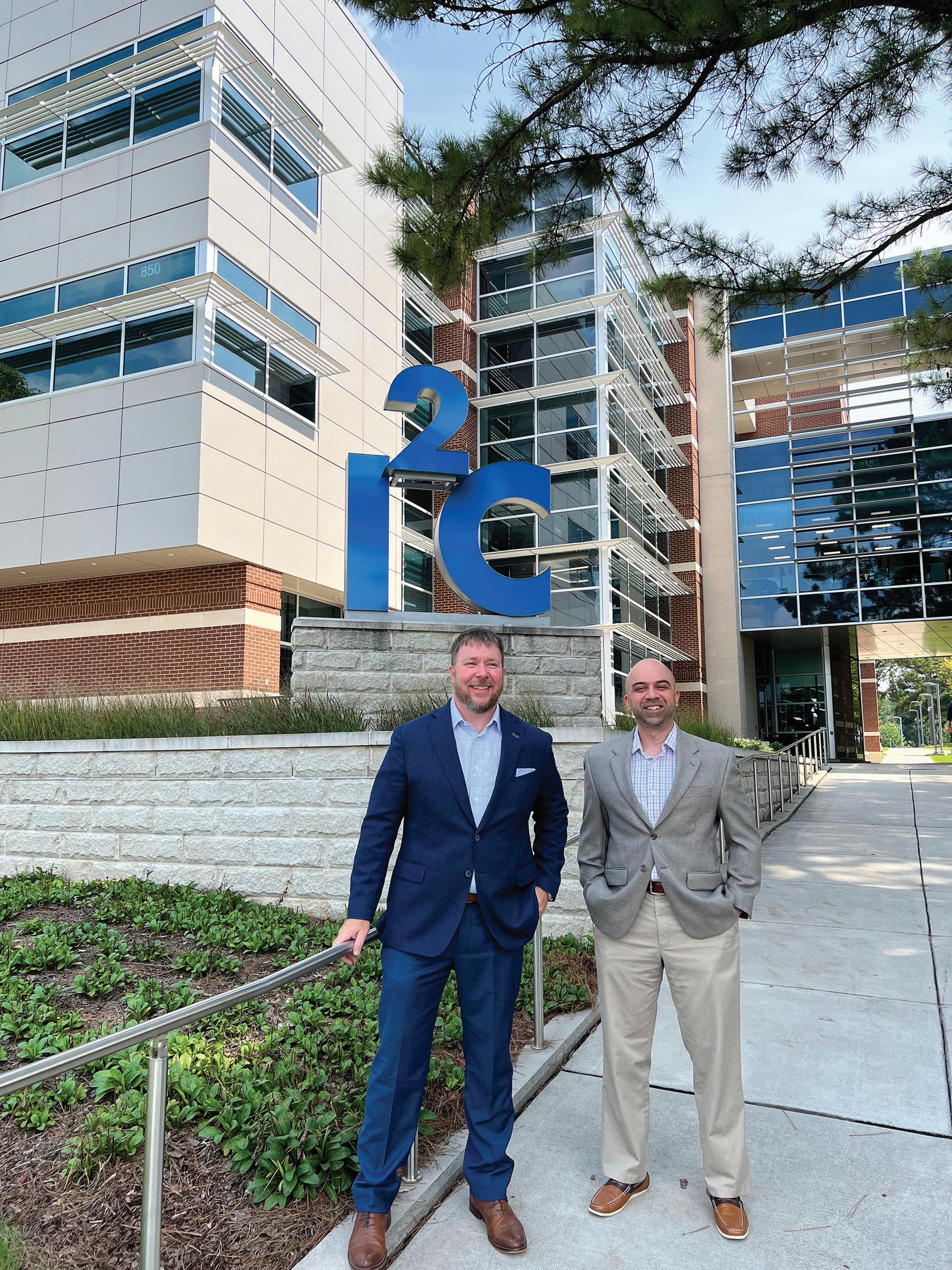
35 minute read
By Dawn Suiter
from HBJ October 2022
Accelerating Success: JS Solutions Takes Off with Help of I2C
By Dawn Suiter / Photos by Dawn Suiter
Advertisement
For local entrepreneurs, especially those in the tech field, it’s no secret that the Huntsville community is renowned for its support of businesses. There’s no reason to go it alone with the wealth of resources that are readily available, one of which is the Invention to Innovation Center (I²C), a high tech incubator located on the UAH campus adjacent to the Business Administration Building (BAB).
The I²C facility houses 30 office spaces within its 45,000 square foot, $16 million facility, which combines three interconnected elements: shared workspaces, a co-working community, and collaborative co-creation. In addition to its building funds, it received an additional $1.5 million in funding for programmatic and strategic initiatives to better serve its mission.
I²C Director Rigved Joshi came on board in 2017, bringing 15+ years of experience in technology development, startup commercialization, venture capital/private equity, and business management. Previously, he managed New Ventures at Vanderbilt University, resulting in 22 startups raising over $7M in early stage venture and research funding.
According to Joshi, the goal of the I²C was very simple: to build resources around the incubation strategy, creating a sort of watering hole for entrepreneurs and startups so they could take their ideas to the next level.
Jason Swafford’s company, JS Solutions, was one of the first to move into the I²C, coming on board in September 2019 as a oneman operation.
“Currently, we have about 25 companies who are physically located here and the goal is to focus on technology-based entrepreneurship,” Joshi explained. “We are always a little less than full and the reason for that is we always want to keep some office space which is available for churn.”
“Besides biotech, life sciences, and traditional healthcare, we want to try to embrace, as much as we can, other technologies–we have EdTech, we have FinTech, cyber, robotics, 3-D printing, additive manufacturing, apps, traditional software, things like that,” Joshi continued. “It’s a really nice mix of companies, and we have a small subset of companies that are in the government technology space as well. That’s where Jason was–he pretty much opened doors.”
Joshi noted that the current occupants of the I²C range from “companies which have one or two people that haven’t raised any funding all the way to a company [Sinequa, an enterprise search technology company] that moved from France.”
Joshi explained that the I²C strives to create a mix of companies that can collaborate with one another if they want or need to, as well as to “create an environment that facilitates that positive collision or collisions, whether it’s in the hallways, in the cafe areas, in the most organic sense that one would expect in an environment or in a space like this.”
In addition to its collaborative, open environment, the I²C features a mentor program, as well as corporate innovation hubs, which allow companies with mature business models to use the facility as a skunkworks or a sandbox for their innovations.
The I²C provided the perfect environment to enable JS Solutions to get off the ground. Swafford explained that after leaving his former employer, he felt there was a need for a small business that would focus more on its employees and its customers.
“That’s not to say that the places I worked for previously didn’t, but I felt like we could do it differently and better,” he said, adding that “there
Pictured left to right: Jason Swafford and Rigved Joshi
were always outside influences on our decision making that weren’t local in Huntsville. Huntsville is different–it’s a different animal specifically in government contracting and the way technology starts and grows and develops here.”
“My time there taught me everything I needed to know about how to get here and to do this, and I got to see all kinds of examples of good, bad, ugly, right, wrong, indifferent, just all kinds of experience in different scenarios,” Swafford continued, explaining that he worked for another company for a year after his departure. “During that year it was really eating at me that ‘this is the time when I can go start something.’”
As the sole earner in a single income family, Swafford needed to find a way for the company to pay for itself instantly.
“Like, I didn’t really want to go out and deplete savings and risk putting the whole family in financial ruin. My oldest son has special needs so I couldn’t do that. It had to have no impact really to the family or minimal impact to the family.”
After being asked for consulting help by multiple colleagues, Swafford launched JSS, using FreeLogoServices.com to create his company logo.
“Then I picked up a couple consulting clients…I was at one of the RISE morning events and I met the gentleman who was doing the nametags for that group. He was here at the I²C and so I came here to meet
him…they’d just moved into this facility,” Swafford recalled.
“I was three minutes in and I’m like ‘hey, at the end of the meeting I’d like you to introduce me to the director of this facility because I want in.’ Like, this was what I was looking for for an office space to start up but I couldn’t afford office space that looked like this as a one person consulting company.”
In order to be accepted, Swafford said, “you’ve gotta go through an approval process, and to do that approval process they force you to build a business plan. I hadn’t built a business plan yet. I mean, yeah, I knew I was supposed to do these things but I didn’t have time to do that. But to get what I wanted, which was to be in this facility, I had to go through the different requirements to get in. And that helped me kind of formalize some things.
“We built the business plan, [and] we had to justify why we felt like we deserved the privilege to be in the facility. We were fortunate to get accepted,” Swafford said.
Swafford soon realized just how important that business plan would be when he had to go back and read through it again two years later following his nomination for the Entrepreneur of the Year Award.
“I had to go look at revenues and how we went, and my one page PowerPoint slide showed our revenue path…it was exactly where we were, just by complete chance that I predicted that. I had some predictions, as far as I knew what my current bookings were and I knew what my backlog was, but I didn’t know what the growth was actually going to be,” he recalled.
“It was right spot on, to the month, to the hundreds of dollars.”
In addition to forcing him to create a business plan, the I²C provided instant credibility to the startup.
“People would come in and we’d meet here and come upstairs to the conference room and the first thing they’d want is a tour of the facility. Every meeting got derailed for the first 15 minutes and I got used to it… they’d want to know what this is, why it’s here, what’s it all about, and how’d it get here,” Swafford said, adding that he’s given that tour to “everybody who’s ever come to meet here.”
“It has the look and feel of a technology hub. You’ve got all the other businesses here that bring credibility to it, like Accenture, SAIC, and Intuitive. They’re all well-known companies here. By operating in a space that they’re in, that brings subconscious credibility, subconscious bias maybe, and, you know, you look professional.”
In addition to the overall optics of the facility and ready access to private meeting spaces, Swafford made good use of the access to different networks that I²C provides. “If I had a problem, I’d come ask Rigved ‘hey, I’m
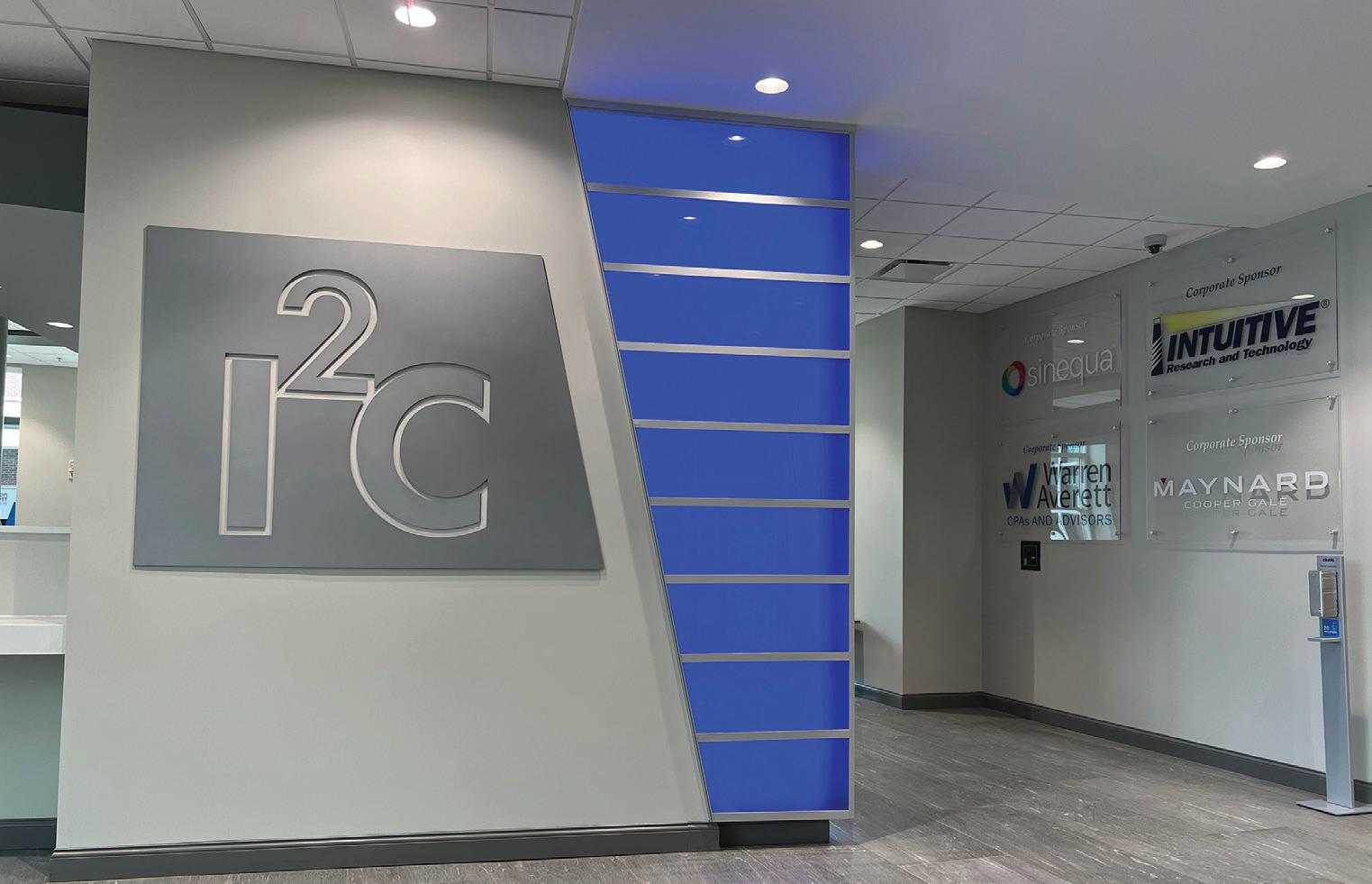

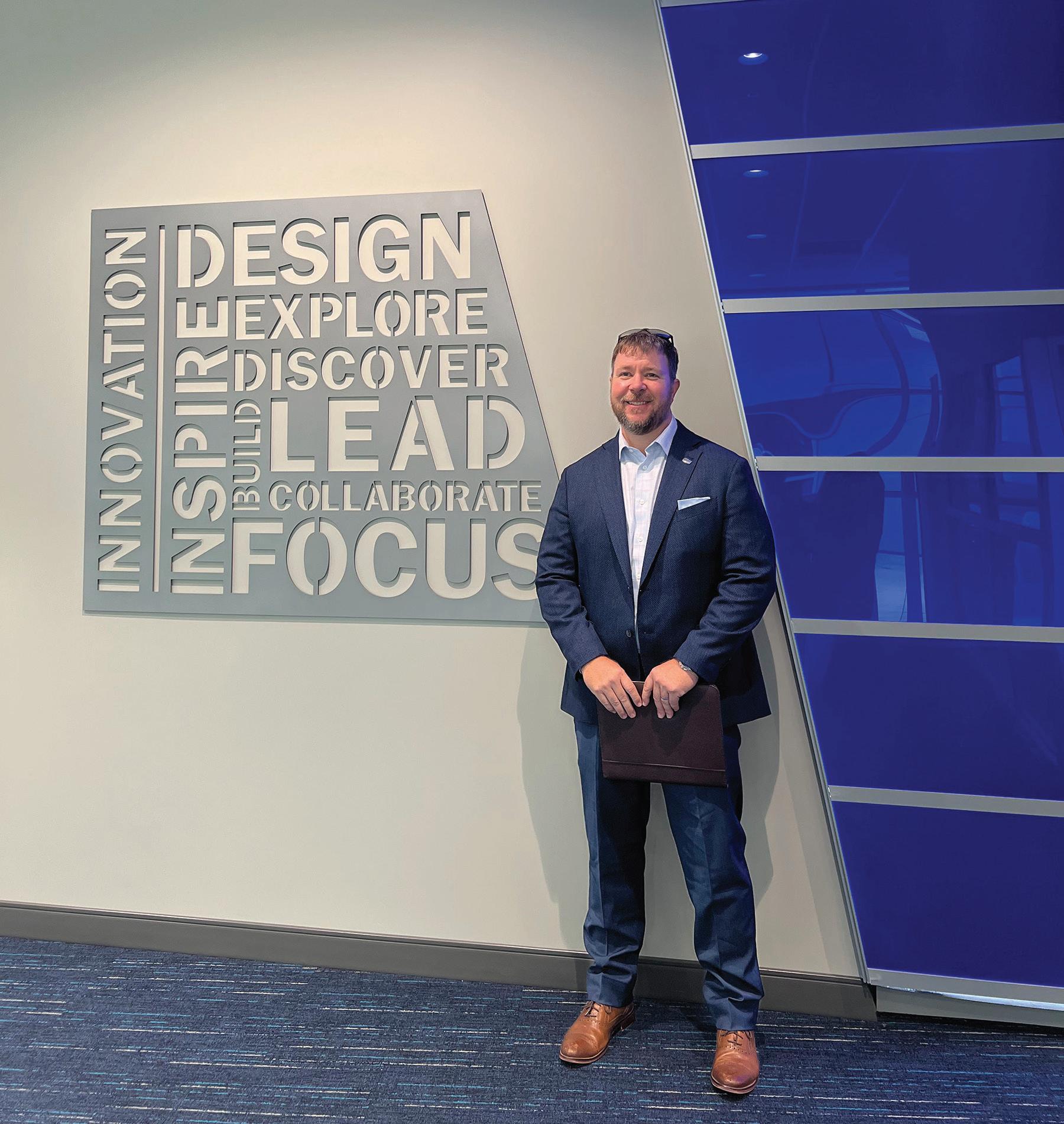
Pictured: Jason Swafford trying to figure this out, I don’t know who to talk to’–he’d give me about 3-5 different people to reach out to every time.”
“These folks, they’ve been through this or they know who to talk to to help me. And sure enough, every time they’d help me get to my solution.”
“If I could really pick my top three entrepreneurs who really leveraged to the max how they could benefit from all the resources we have, I think Jason would be on the top of the list. You know, just the way he utilized the space, he could position his company, make it seem legitimate, as he was growing, to his customers who were not easy to convince,” Joshi added.
And grow, it did. Although Swafford initially wanted to go into some technology fields and work with NASA, clients and revenue dictated the path of the business for the first couple of years.
“The opportunity to switch from consulting to government contracting appeared and we were able to do support for Army Aviation, specifically working with modernized crypto. We still have a technology focus, but it’s a split between logistics and technology support that we still do now for Army Aviation. Once we started into that, that’s when we had our explosive growth,” Swafford said. By the spring of 2020, Swafford had jumped from consulting to government contracting. “Those discussions obviously started months in advance because it takes months to get a contract up and going or to get added to contracts. So I was one person but I had a couple of part time help[ers] when I was doing consulting.” With his client list growing rapidly, the company quickly expanded to five people. “Later that year we were doing good work–we were a good subcontractor to our client and together we managed our contract well. We were responsive to them and we had the opportunity to add some more positions, and then we added two more in the next six months”. By the fall of 2020, the company added three additional positions. Since then, Swafford has had to hire a business manager, then a director of strategy and growth, and most recently, an executive administrative assistant. “We’re 3 ½ years old…we basically doubled in revenue every year.”
JS Solutions also recently won a $46 billion IDIQ contract with the U.S. Air Force.
“This is the one that made us famous for a day,” Swafford quipped.
The IDIQ (Indefinite Delivery, Indefinite Quantity Contract) is a top-level contract where the government brings in multiple awardees, which prequalifies companies to generate competition for specific types of work.
“We won a position with the Air Force on EWAAC (Eglin Wide Agile Acquisition Contract),” Swafford explained. “It’s out of Eglin, Florida, and it’s a $46 billion ceiling, ten-year ordering period…what that means is we won a seat at the table to compete against all of the task orders that will come out on that IDIQ. We are the smallest company sitting at that table.”
Swafford described this as a huge milestone for the company, which required them to assemble a team and lead it to go after the contract. “A lot of the companies that we asked to team with us really weren’t tracking this. Like, they did initial awardees of this in, I think, September of 2021. A month later they announced they were going to do a second onramp of companies because they wanted a broader mix of competition. All the traditional contracting companies kind of went after the big companies to do things…all the top five are in there.”
He noted that a lot of companies weren’t tracking that there was another on-ramping taking place. “It kind of came quietly…a lot of folks just kind of blew it off. Well, we happened to be paying attention and we were like ‘hey, we can do this. We qualify for this. So we went after it. Which forced us to do some things internally in the foundation of the company. It forced us to verify that we had a government-approved accounting process, which is a big deal with government contracting. You have to be legitimate and look like a low-risk possible prime to be awarded a seat at one of these tables.”
JS Solutions has since acquired its GSA schedule, another prime contract with the government that allows the company to bid on additional items. “We shock a lot of folks all the time–I say we fight above our weight class. We’re a small company that’s not the traditional small business contractor in town…I’ve got a good team wit a mix of abilities and we’ve done big things like this in previous organizations, working in a big company with a big company’s resources behind us. We’re like ‘we can do those same things, we just have to do it a little differently,” Swafford said.
“This sets the stage for us to have explosive growth over the next ten years. One of my goals is that we’re trying to get to be a 30 or 50 person company within 3-5 years from winning that IDIQ…it’s possible, it’s doable–you just have to put the hard work in.”
Joshi noted that Swafford “was one of the very few who was able to see and identify, pinpoint, exploit, and leverage everything that we were trying to build and create for one-man entrepreneurs like he was.” Returning to the topic of churn, he explained that exits for the I²C included its resident companies failing, being acquired, or going IPO.
“But there’s a very legitimate exit that we could quantify, which is growth,” he added. “Every time someone asks me ‘have you had any exits,’ I always say we’ve had three so far–[Swafford] was the first one who moved out of the I²C for the right reasons because he grew from one person to 15 people, moved from a 300 square foot office to 3,000 square feet. To us, that’s an exit, and for our stakeholders that comes as very positive…it checks boxes across various metrics that we track.”
JS Solutions celebrated its continuing success by cutting the ribbon on its new facility on September 20. The ceremony itself marked a new chapter in Huntsville history with a joint ribbon cutting for both the Madison and Huntsville-Madison County Chambers of Commerce, symbolizing a new collaborative energy fueling North Alabama’s small business ecosystem.
Swafford is proud of the fact that in addition to repeated nominations for the Entrepreneur of the Year Award, his company won silver in the
Huntsville Chamber of Commerce’s Best Places to Work Awards this year. “That shows we take care of our people and that people want to come work with us. When we’re recruiting and talking to folks, everyone in town pays attention to that. Whether they tell you that or not, they are.”
“Those things keep showing up and happening because we’re putting in the hard work to grow the customer relationship, to grow our employee relationship. If both of those are not happy and they’re not happy together then we’re not going to exist, and the company won’t exist unless the employees and the customers all like each other and want to work together. Now we’re up for Small Business of the Year as a contender, and we’re hopeful that we’ll do well there,” he continued.
Swafford considers the Best Places to Work Award to be the one he cares most about “because that’s our report card from our employees on how we’re doing on taking care of them.”
Although he sees this as the company’s pathway to growth, Swafford noted that the focus isn’t so much on the number of employees as it is its ability to take care of the people within the company. “That’s success…I want to make sure we don’t lose sight of that right there. It’s not just about the growth revenue or the awards. It’s making sure that we stay humble and take care of our people, who will take care of our customers and vice versa. Everything else will kind of take care of itself outside of that.”
Swafford noted that his first office space at the I²C was #320, coincidentally the same number as JS Solutions’s new corporate headquarters at 150 West Park Loop in Huntsville. “I looked at two other offices between when I was getting ready to move out–they were also 320. It was weird. So our next office will have to be 320, I guess.” w
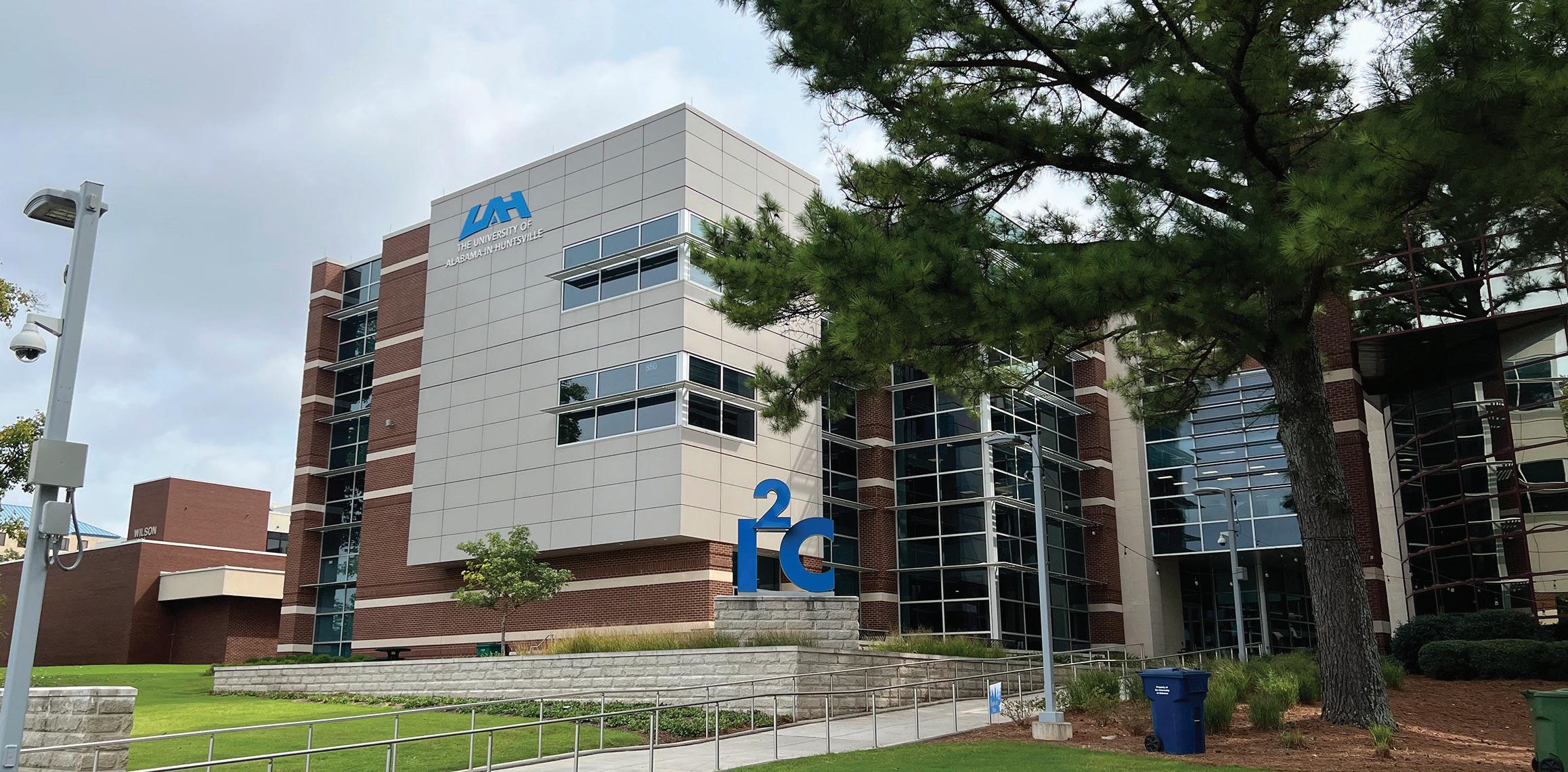

When Wernher von Braun and a collection of fellow rocket engineers and scientists were sent to Redstone Arsenal in 1950, the city’s trajectory would be altered forever, especially after President Dwight D. Eisenhower transferred the group from the Army to the newlyformed National Aeronautics and Space Administration a decade later.
“When they brought the German rocket team back in the 50s, or whenever it was, to Redstone (Arsenal) that changed the face of Huntsville,’’ retiring U.S. Senator Richard Shelby told a crowd of over 900 at the Washington Update Breakfast at the Davidson Center for Space Exploration. “Thank God.’’
The 88-year old Shelby obviously had no idea at that time, but the arrival of the Operation Paperclip crew from Fort Bliss, Texas, following their relocation to the U.S. after World War II to what would become the Rocket City, would also have a profound impact on his political career.
He’s retiring at the end of his current term, his sixth in the Senate following four in the House of Representatives. He’s serving 36 years as a Senator, including 8 additional years as a Congressman. A large portion of his time in Washington, D.C. was spent pushing projects to Huntsville in support of the space and defense industry.
That’s something that has not gone unnoticed in the community. Madison County Commission Chair Dale Strong, speaking for Mayors Tommy Battle of Huntsville and Paul Finley of Madison, presented the senator with a framed resolution declaring Sept. 19 Richard Shelby Day in Madison County.
Shelby received two standing ovations at his final update in the city, this one on the grounds of the U.S. Space and Rocket Center.
“Somebody said to me one time, ‘Who do you work for?’ I said I spend about half of my time and probably 65 percent of our time in my office working for Huntsville because it fuels North Alabama and half of Tennessee economically,’’ Shelby said. “But, more than that, (Huntsville) has a purpose for national security, for the space program, and now it’s going to be for security like the FBI that is going to have a huge presence here, as you know.’’
Shelby has steered hundreds of millions of federal dollars for projects to the Tennessee Valley over the years. Two of his latest triumphs were landing $2 billion for the FBI campus on the arsenal and a new federal courthouse downtown.
“He has led the way for our efforts to grow and diversify Redstone, to maximize its value to the U.S. government including making Redstone the FBI’s unofficial second headquarters operation,’’ Huntsville/Madison County Chamber Board Chair Greg Brown said. “He has brought tremendous resources to our local universities and challenged them to become leaders in research and development.’’
Shelby’s time on The Hill was spent supporting not only Alabama but Huntsville in particular.
“Senator Shelby has been a champion of Marshall Space Flight Center and has led the fight to preserve U.S. leadership in space exploration through his support,’’ Brown said. “He’s been the voice of reason we’ve looked to.’’
When introduced at the breakfast address, Shelby received a standing ovation. Later in the day, he received more applause at the groundbreaking ceremony for the new federal courthouse downtown.
“Thank you. Wow. My gosh, thank you very much,’’ he told the Davidson Center crowd. “I remember my first trip to Huntsville – and I drove in here by myself many years ago. I think I was in the state senate then. I was just looking for a service station. I was about out of gas. And I didn’t have this kind of welcome.’’
He certainly got a raucous reception during what will surely be one of his final official visits to the city.
“I don’t know what to say but, ‘Thank you,’ ’’ Shelby said. “I’m grateful for 36 years in the Senate and eight in the House, not from this district, though. Thirty six years is a long time and a short time – I guess it’s how you calculate it.
“A lot of people in this room have helped me over the years, helped me get elected and re-elected and re-elected and re-elected, and I’m grateful for that and thankful for that. Being in the U.S. Senate is a great opportunity for somebody, but you’ve got to take that opportunity and try to do something with it. I certainly have tried, but one person can’t do it. Look at what you’ve done in Huntsville and all of you together and your people over the years.’’
A lot of what Huntsville has done to become what U.S. News and World Report named No. 1 on its Best Places to Live rankings goes back to Shelby.
“Just look around,’’ Battle said. “Everything that has happened in Huntsville, somewhere, has his fingerprints on it. We’re dedicating a federal courthouse (Sept. 19), and that courthouse is here because of Richard Shelby. You look at the arsenal and the FBI presence. It’s here with the fingerprints of Richard Shelby on it.’’
Distinguished career
Shelby, a native of Birmingham and fifth-generation Alabamian who now resides in Tuscaloosa, has an impressive resume: • Undergraduate and law degrees from the University of Alabama • Tuscaloosa city prosecutor (19631971) • U.S. magistrate for the Northern
District of Alabama (1966-1970) • Special Assistant Attorney General of Alabama (1969-1971) • Alabama State Senate (1970-1978) • U.S. House of Representatives (1978, re-elected in 1980, 1982, and 1984) • U.S. Senate (1986, re-elected 1992, 1998, 2004, 2010, and 2016) • Switched from Democrat to Republican Party (1994) • Longest serving senator from Alabama
Committee assignments:
• Senate Committee on Appropriations (current vice chair, former chair) • Banking, Housing and Urban Affairs (former chair) • Rules and Administration (former chair) • Senate Intelligence (former chair)
Sub-committee assignments:
• Commerce, Justice and Science • Defense • Energy and Water Development • Homeland Security
By Mike Easterling / Photos courtesy of Huntsville/Madison County Chamber
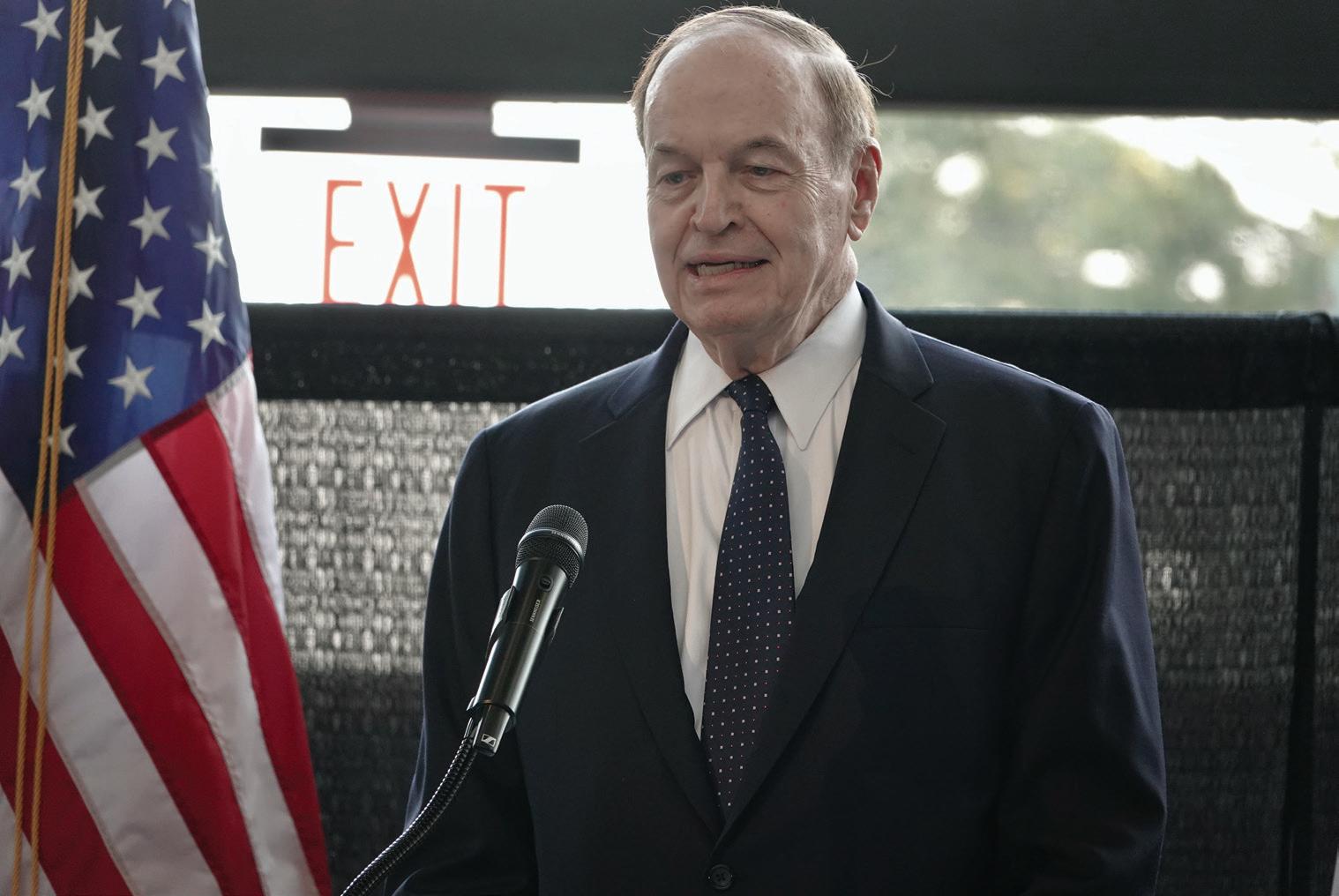
Alabama Senator Richard Shelby
Alabama Senator Richard Shelby (left), (Seated man?), and Kimberly Robinson, US Space & Rocket Center CEO and Excutive Director (center)
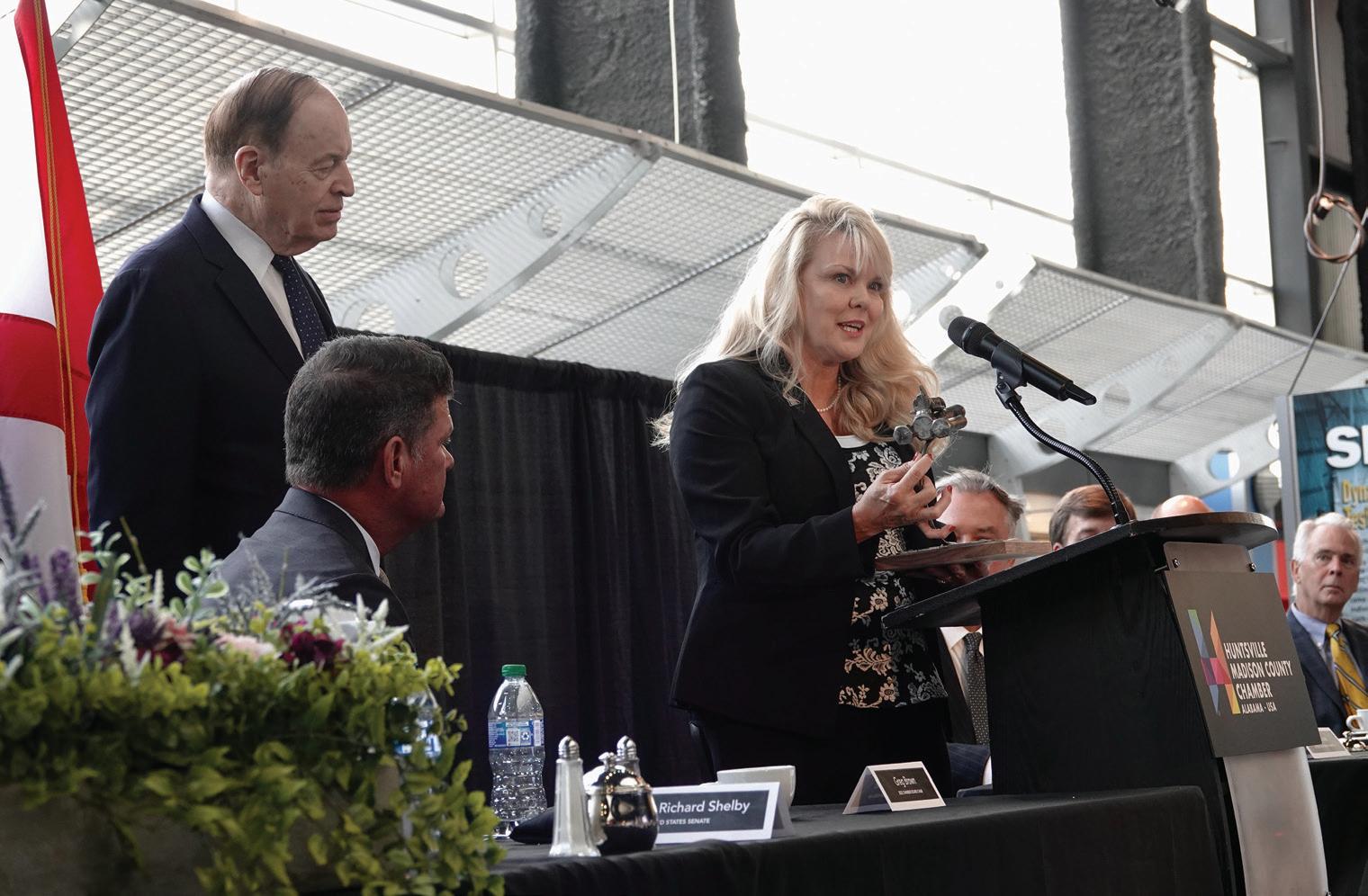
/ Photos courtesy of Huntsville/Madison County Chamber
• Labor, Health and Human Services,
Education and Related Agencies • Transportation, Housing and Urban
Development and Related Agencies
“He’s the fourth most senior member of the Senate,’’ Brown said. “He has been our champion in the D.C. arena, defending our state and especially Huntsville for those who don’t share the same level of enthusiasm for our federal activities.’’
Ronnie Chronister, Vice Chair of Government and Public Affairs for the Huntsville/Madison County Chamber, called Shelby “the most effective member of Congress the state of Alabama has ever had.”
“He’s leveraged his position on the Appropriations Committee to make sure the needs of the nation are met while at the same time matching the cause for Alabama.’’
Huntsville, which Battle claimed has a competitive advantage over other cities because of, among other things, a low cost of living and a strong workforce, has greatly benefitted from Shelby’s efforts.
“Somebody had to start the thought of looking at Huntsville, and that’s Richard Shelby,’’ Battle told the Huntsville Business Journal. “He’s been the one who has done that, the one who has said ‘Huntsville is a great place to come’. ’’
Battle added, “A lot of people will say that’s pork coming in. It’s not pork. We’re doing the job that has to be done in America and we’re doing it for a better price than anyone else can and we do it better than anyone else can.’’
Political fighter, and got jokes
During his breakfast address, Shelby said he would be “remiss if I didn’t think back about some of the people I served with,’’ particularly the late Howell Heflin of Tuscumbia. Heflin succeeded fellow Southern Democrat John Sparkman, who was born in Hartselle and set up a law practice in Huntsville.
“Senator Heflin was a good friend of mine,’’ Shelby said. “He took me under his wing – he was a big man – he took me under his wing when I first went to the Senate. I remember we worked together and the program then was to build what is now known as (the Sparkman Center Complex on Redstone Arsenal). They said, 'Gosh, can you get the money?’ Well, it's a fight. It was a bigger fight then and we did it.’’
Shelby also recalled working with his then-Chief of Staff Tom Young on turning the Von Braun Center into a complex and began expanding NASA. Later came Base Realignment And Closure (BRAC).
“Huntsville had a lot to offer,’’ Shelby said. “We got some commands here that are very powerful and very important to national security.’’
Shelby said he hopes the Omnibus Appropriations Bill, which includes defense spending and will expire at the end of September, will get support to be extended temporarily on Oct. 1 until a larger act can be addressed for Fiscal Year 2023.
“Inflation has been running close to 10 percent’’ he said. “That means last year’s military budget has probably already lost 10 percent. We’ve got to plus that up to keep up and we need a little more than that to show the world that we’re serious about our commitments in the world.”
The recently passed Inflation Reduction Act of 2022 is advertised as a bill that “will make a historic down payment on deficit reduction to fight inflation, invest in domestic energy production and manufacturing, and reduce carbon emissions by roughly 40 percent by 2030.’’
In addition, the act promises to “protect Medicare recipients from catastrophic drug costs by phasing in a cap for out-ofpocket costs and establishing a $35 cap for a month’s supply of insulin. And, as an historic win, Medicare will be able to negotiate prices for high-cost drugs for the first time ever.’’
Shelby, who deemed inflation “rampant across the globe,’’ is not impressed.
“Biden’s plan?’’ he asked the HBJ when the subject was brought up during a media opportunity following his Update. “They call it that. It’s not a reduction. They’re borrowing money that’s got to be paid. I voted against that. The Democrats – they just put a name on it. That’s not going to reduce inflation. It’s probably going to aid and abet inflation.’’
Shelby added that the key to reducing inflation was to “get our supply chain moving in the right direction in the world. That will help a lot because we’re all interdependent on it in the world economy.’’
As for the FBI, the senator called the budding campus something that “you’ve never seen anything like it.’’
“They’re going to be on the cutting edge. And why did they want to be here? Because of the talent here, because the engineers and scientists are here, because they have to be on the cutting edge.’’
The old Red Menace and its authoritarian President Vladimir Putin, who is threatening to use nuclear weapons as it continues its invasion of Ukraine, hogs headlines. But Shelby, who said he supports the U.S. and allies giving aid to Ukraine in its struggle, the former communists country is not at the forefront of his concerns.
“People worry about Russia, but they better think about China’’ he said. “China will be our biggest economic competitor, already is, and it’s going to be more so. Also, they’re interested in global hegemony economically, militarily, politically – everything.
“They’re taking their time building. They’re our biggest challenge down the road, they’re our biggest challenge in the Pacific.’’
Retirement nears
With Shelby’s final Senate term coming to a close, the state’s and city’s future is in the hands of first-term Republican Senator Tommy Tuberville, the former Auburn football coach, and the heavily-favored general election Republican candidate Katie Britt, wife of former Alabama and New England Patriot lineman Wesley Britt.
In a deeply red state, a local candidate for the House of Representatives, the aforementioned Strong who is also a Republican, is likewise expected to win in the general election.
Britt has served as Shelby’s Chief of Staff and the senator has worked closely with Strong. He endorses both, as does Mayor Battle.
“We’ll miss him,’’ Battle said. “But, we’ve got two great senators coming behind him.’’
Battle said Tuberville was ahead of most issues and is “doing fantastic.’’ Britt, he said, was “one of the best legislative leaders I’ve seen in a long time.’’
Shelby also complimented Tuberville on “working hard’’ and said he was impressed by Britt “as a fighter’’ when she first interned in his office as a press liaison and later as CoS. It turns out Shelby had no choice in bringing Britt aboard as his wife of 62 years Annette, a professor emerita at the University of Alabama, made sure it happened.
“She told me to hire her,’’ Shelby said. “She didn’t say interview her, she didn’t say talk to her, she said hire her. And I knew to do that.’’
Shelby’s retirement date is Jan. 3. Until then there are projects yet to be secured. At the forefront is Space Command, which was awarded to Huntsville but is still in limbo with Colorado Springs fighting to keep it there.
The relocation was made by the Trump Administration at the end of his term as President and was backed by the Department of Defense. But, as Shelby said, nothing is ever “final in Washington.’’
“Politics plays a role here. I think we have to be alert that it’s not here, yet. But we hope it will come and things are in place. The steps thus far are good.”
That fight could be the last major battle for Shelby until he leaves office, when thereafter he said he’ll “go home to Tuscaloosa and probably just go to the mailbox for my wife.’’
Until then, he’ll keep doing the job in the Congress that he’s done since 1978.
“I owe a lot of you a lot of gratitude, a lot of thanks, for letting me be one of your two U.S. Senators for a long time,’’ he told the breakfast crowd. “I’ve got a few more months left, and we’re hoping to go out pretty strong in the fall.
“If we do, Huntsville will know.’’ w
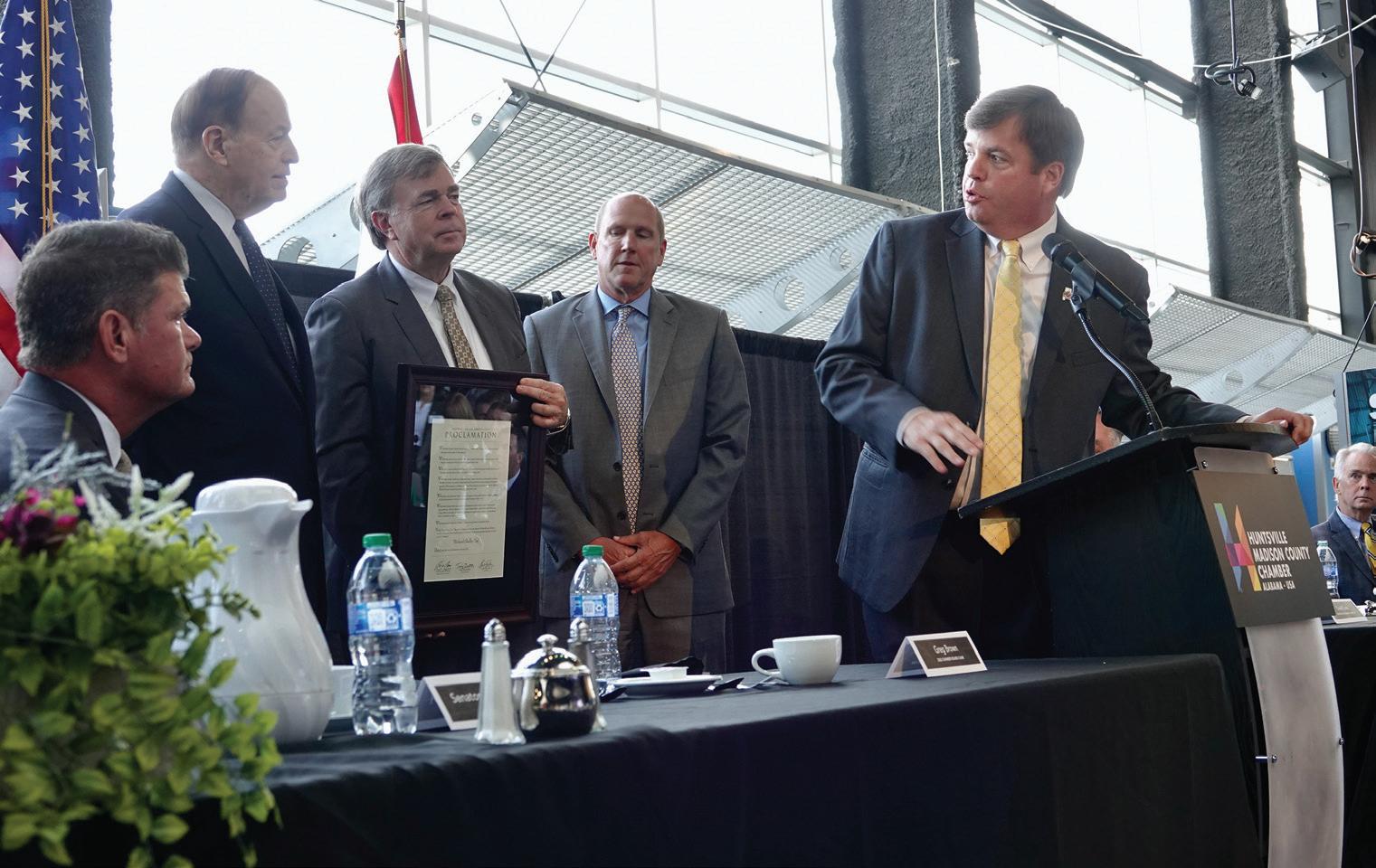
Pictured L to R: (Seated man?), Senator Richard Shelby, Huntsville Mayor Tommy Battle, Madison Mayor Paul Finley, County Commission Chair Dale Strong
Corporate Tax Season is Coming: Are You Prepared?
By Dawn Suiter
For business owners in Huntsville and beyond, tax season is likely high on their list of priorities right now as the end of year quickly approaches. The Huntsville Business Journal recently met with Huntsville CPA Jared Sharp of Warren Averett to discuss recent developments and pro tips for businesses as they enter the year-end planning period for the 2022 tax season.
According to Sharp, now is the time for businesses to focus on yearend planning in order to examine what they can do now for tax planning purposes that can help them save money when they file returns in 2023.
Sharp stressed the need for continual communication between businesses and their CPAs as key to making sure they’re doing everything they can to save. “Having that idea of when are you going to file, when are you going to be ready to file, how quickly can you have the books closed, if you’re getting a financial statement audit done–the timing of that is important because you want to file your taxes after that’s completed.”
“Hopefully most people already have their CPA identified, but if not you should probably be talking to them now–it’s too late once you get into January and February because we’ve already laid out our schedule for that time frame. If you don’t have a CPA that you’re working with that needs to be number 1. Identify them now.”
Despite the negative perception of filing for an extension on taxes, Sharp explained that it can be beneficial for a lot of companies due to the short time frame between the end of the year and filing deadlines.
“In January, you’ve got to close your books and file a tax return by March for a pass-through entity and by April for a C Corporation,” he said, explaining that the additional time can provide businesses with the opportunity to more thoroughly prepare. ”Your CPA has more time to look at everything too. But having those conversations now is probably good to get an idea of what you need to do.”
While there aren’t a lot of changes from the previous tax year to this, Sharp noted that there is one major change that should be getting more attention than it currently is because of its potential impact on companies doing research and development.
While this change in the tax code took place in 2018, it does not take effect until 2022. Sharp explained that because it was five years out at the time of its enactment under the Trump administration, not a lot of people paid attention to it.
“Every time they make a tax law change you’re decreasing taxes here, but you gotta raise them somewhere else to budget it out,” he said. “Basically in 2018 when all those tax laws and tax cuts came in under Trump, this was one lever they had to push up to say ‘in 2022 we’ll recoup some of these costs by taxing the R&D costs by allowing it to be a deduction over 5 years versus today.’”
Under this code, Sharp explained, R&D expenses such as wages, supply costs, and anything else that goes into R&D efforts by U.S. companies will have to be categorized and amortized for five years for tax purposes. For foreign-based companies, this period increases to 15 years.
“Before 2022, you actually could expense immediately any of those costs. So that’s a big change for a lot of companies that may have R&D efforts that are heavy. Think about your biotechs, your software developers, for anyone that’s heavy into R&D that can be a big change,” Sharp said.
This translates to higher income on paper due to initial expenses not being deducted. Sharp added that there is talk in Congress to reverse this change before the end of the year, “which I think will be a good thing if they do because if you’re having to capitalize all of your R&D activity versus expense them, you’re kind of disincentivizing that spin on R&D.”
The Biden administration’s Inflation Reduction Act will primarily impact large corporations with over $1 billion in income, but Sharp noted that the energy credits and green initiatives included within that package may have ben-

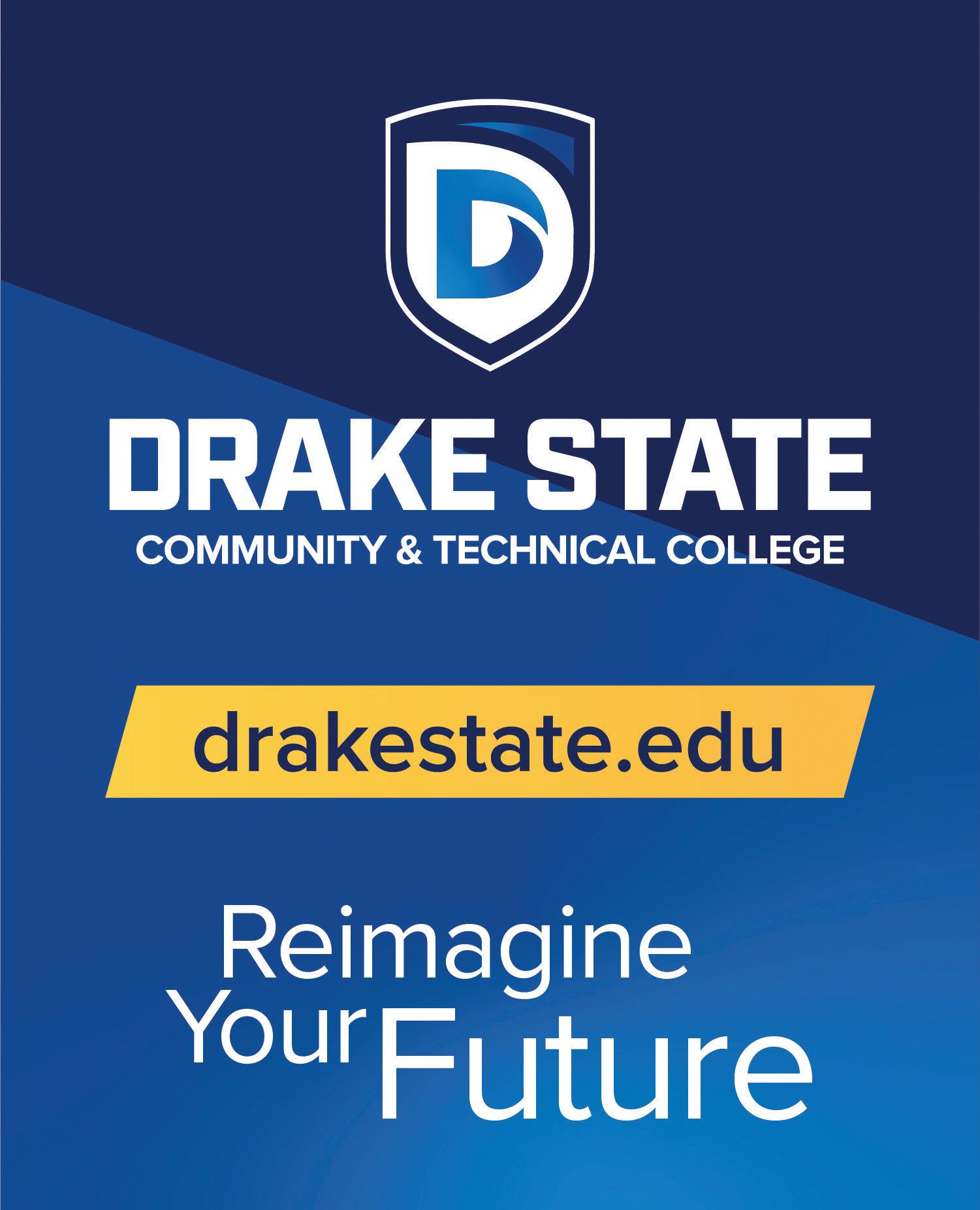
efits for a broader range of people. “Those are out there, and I’d advise anybody that’s looking at buying a car or any type of home improvement activity that there can be some credits,” he said.
Sharp’s first piece of advice for new business owners: “Hire a good attorney and hire a good CPA. That’d be step #1.” He admitted that while it can be hard to balance for startups concerned about cost, it’s important to “hire the best that you can afford.”
Building a relationship with a good CPA is an important step in building a healthy business: “We don’t want to see you just one time of year when it’s time to do taxes–we want to work with you throughout the year,” he said.
Communication is key, he explained, because it allows your CPA to think about how things apply to your business and to help create a game plan that will best benefit your company financially.
This is particularly important when it comes to preparing for tax returns. Early planning is critical, Sharp explained, because if steps are missed during the current calendar year it’s difficult to fix errors retroactively.
Make sure you can find the best you can afford, make sure you’re talking to them and planning, have regular conversations and let them know what you’re doing–that’s going to be the best thing you can do because of everything they can help you think about.”
Another valuable piece of advice: find a CPA and, for that matter, an attorney, who has expertise in the particular industry you’re working in. “If you’re a BioTech person, a GovCon person, if that’s what your company is doing, you want to look for a CPA that has a background in that line of work because there’s a lot of industry-specific items that come with accounting and taxes,” he said.
Sharp noted that a general accountant that works with a wide variety of businesses may not realize that a BioTech or GovCon company, for instance, can do different things when it comes to taxes than other businesses.
According to Sharp, while Warren Averett may not be the lowest-cost service, it provides value-added benefits that can bring real benefits to its clients. “We take a holistic approach to our clients–what that means is we’re not looking at just the tax stuff. You can hire us just to do your taxes but we’re also going to be looking at what we can do to help your business overall–we have a lot of different services we offer, so we want to make sure we’re introducing you to the right people inside the organization that can help you with any need you may have,” he said.
Sharp described tax returns as “the byproduct that comes out of the relationship.”
Ideally, he added, there will be no surprises. “Hopefully you already have an idea because we’ve been working together on what that tax bill’s going to look at come April, what [you’re] going to owe…we’ve already been working towards that so it’s not a surprise when we go to file the tax return.” w

Real Estate Update: August Report Shows Residential Trends Continuing
By Marie Johnson / Graphics courtesy of Huntsville Area Association of Realtors
The Huntsville Area Association of Realtors has released its monthly report for the month of August, 2022.
Madison County homes spent an average of 11 days on the market, a stark contrast to the national average of 42 days.
Despite the continued quick pace of sales in the county, Madison County experienced a 100% increase in the number of residential units in inventory since August of last year. This has resulted in a slight dip in the average value of 6% since June, but the continued upward trend of prices still holds, as the average price is up 11% from August of 2021.
The combination of that slight price dip and larger inventory of available units can make for a strong pitch for realtors looking to convince would-be buyers that this is a good time to buy; there is a wide variety of units available to suit the tastes of various clients, and while the market is beginning to settle from the pandemic, there is no reason to assume that prices won’t continue to rise over the long term - though more of a steady, holistic rise of a booming city’s expansion instead of an unstable, frenzied bubble.
According to realtor.com’s national report, the national average listing price of $435,000 had declined from the previous month’s high-water mark of $450,000. Madison County’s average price continues to slide in below that national average, with August’s average of $367,000 reflecting that 6% dip from July’s $391,000 benchmark, but that is still higher than August of last year’s price of only $330,000.
With many businesses looking to open branches or transfer operations to Huntsville, it will continue to be important to emphasize units with easy access to the growing business and research facilities in town. Redstone Gateway is currently greenlit to begin construction on a new, multi-story office building on Rideout Road, and the University of Alabama is at the center of a massive renewal project. With both projects placing a strong emphasis on green space, beautification, walkable infrastructure and employee amenities, property around the two developments could well experience a rise in value specific to those locations.
As always, the Huntsville Business Journal will keep its readership informed of these developments, and will continue to track real estate trends for our fair city. w
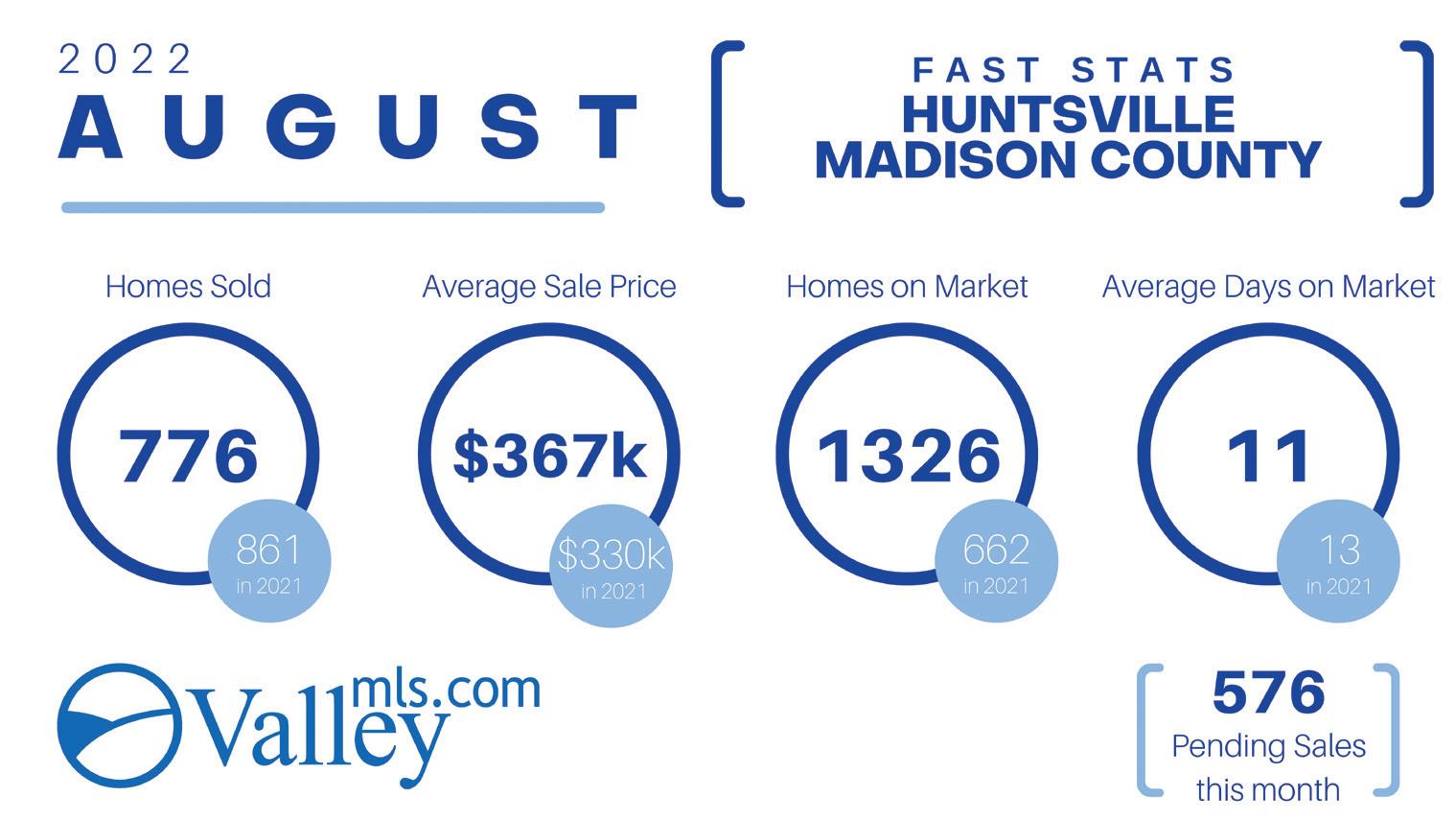

Above left shows the real estate market of Huntsville Madison County. Above right shows the combined market of Limestone, Dekalb, Etowah, Cherokee, Jackson, Marshall, and Madison counties




